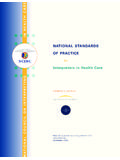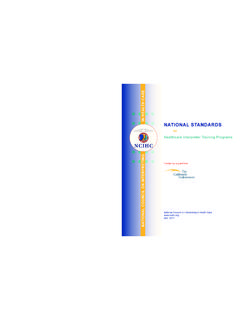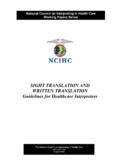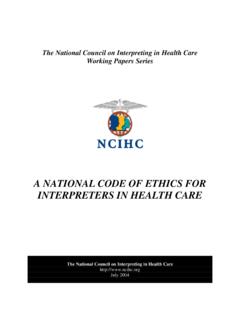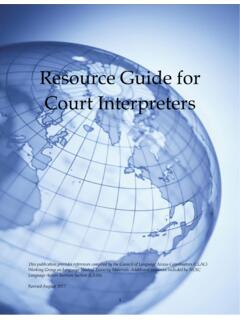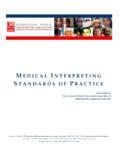Transcription of SIGHT TRANSLATION AND WRITTEN TRANSLATION ... - NCIHC
1 The National Council on interpreting in Health Care Working Papers Series SIGHT TRANSLATION AND WRITTEN TRANSLATION Guidelines for Healthcare Interpreters The National Council on interpreting in Health Care April 2009 SIGHT TRANSLATION and WRITTEN TRANSLATION : Guidelines for Healthcare Interpreters Acknowledgements This working paper was researched and WRITTEN by the Standards, Training and Certification Committee of the National Council on interpreting in Health Care, with input from NCIHC members around the country. It was reviewed and approved by the Board of Directors in March 2009. Standards, Training and Certification Committee Shiva Bidar-Sielaff, MA, co-chair Karin Ruschke, MA, co-chair Maria-Paz Avery, PhD Bruce Downing, PhD Gregory Figaro Carola E. Green Linda Haffner Cynthia E. Roat, MPH NCIHC Board of Directors Wilma Alvarado-Little, MA, co-chair of the Board Joy Connell, co-chair of the Board Barbara Rayes, Secretary Maria Michalczyk, RN, MA, Treasurer Niels Agger-Gupta, PhD, co-chair, Policy and Research Committee Enrica Ardemagni, PhD, co-chair, Organizational Development Committee Shiva Bidar-Sielaff, MA, co-chair, Standards, Training and Certification Committee Rashelle LeCaptain, co-chair, Outreach Committee Lisa Morris, co-chair, Organizational Development Committee Paz Ang lica Snyder, co-chair, Outreach Committee Jason Roberson, co-chair, Membership Committee Karin Ruschke, MA, co-chair, Standards, Training and Certification Committee Jorge Ungo, co-chair, Membership Committee Doreena Wong, JD, co-chair, Policy and Research Committee National Council on interpreting in Health Care, 2009 pg.
2 2 SIGHT TRANSLATION and WRITTEN TRANSLATION : Guidelines for Healthcare Interpreters I. Introduction Language professionals are often assumed to be able to perform a number of language functions (or tasks or services) by the lay public. It is little understood that different language functions require different types of language skills, each of which, when used for professional purposes, is best honed through training and practice. Three of the functions that are the purview of language professionals are translating, interpreting , and SIGHT translating. While these three functions require similar skills such as a good memory, the ability to analyze meaning, and knowledge of terminology, each also relies on different skills within the four domains of language listening, speaking, reading, and writing. While interpreting and TRANSLATION tend to occur in different settings and contexts, there is a small but troublesome area of overlap. The overlap occurs when interpreters are asked to express orally what is in a WRITTEN text ( SIGHT TRANSLATION ) or when interpreters are asked to convert into writing a text WRITTEN or spoken in another language ( TRANSLATION ).
3 These scenarios present a number of questions. Under what circumstances is it appropriate to ask an interpreter to read a WRITTEN text and simultaneously give an oral rendition in another language ( SIGHT TRANSLATION )? Should an interpreter be expected to produce WRITTEN translations in the course of his/her interpreting duties? If so, under what conditions? What additional training should an interpreter have to develop the necessary competencies in either of these functions? This position paper focuses on the special demands of SIGHT TRANSLATION and WRITTEN TRANSLATION in the context of the work of spoken language interpreting . It offers general guidance on the appropriate provision of SIGHT TRANSLATION and WRITTEN TRANSLATION services by a spoken language interpreter. It is imperative that both consumers and providers of interpreter services understand the issues around on-the-spot TRANSLATION by interpreters in order to ensure the highest quality of service. In order to understand the distinctions among these three language functions, this paper first defines each type and describes the skills that are central to the competent exercise of each function.
4 1. interpreting : interpreting is the oral rendering of spoken or signed communication from one language into another. Central to spoken or signed language interpreting are the following skills: the ability to comprehend the intended message of oral communications in two languages (listening skills), and the ability to produce an accurate and complete conversion from one language into another (speaking or speech productions skills). interpreting requires listening and speaking skills in the two languages being used. Depending on the context, interpreters are often called upon to provide bidirectional conversions that is, from language 1 into language 2 and from language 2 into language 1 in the moment. 2. WRITTEN TRANSLATION : Often referred to only by the term TRANSLATION , WRITTEN TRANSLATION is the rendering of a WRITTEN text in one language in a comparable WRITTEN text in another language. Central to WRITTEN TRANSLATION are the following skills: the ability to comprehend WRITTEN text in one language (reading skills), and the ability to produce a comparable rendition in WRITTEN form in a second language (writing skills) into another.
5 Most professional translators provide only unidirectional translations, as a rule working into their dominant language. Unlike spoken or signed language interpreters, translators often have the luxury of time and other resources to come up with the best way to capture the nuances of meaning in the original text. National Council on interpreting in Health Care, 2009 pg. 3 SIGHT TRANSLATION and WRITTEN TRANSLATION : Guidelines for Healthcare Interpreters 3. SIGHT TRANSLATION : SIGHT TRANSLATION is the oral rendition of text WRITTEN in one language into another language and is usually done in the moment. Central to SIGHT TRANSLATION are the following skills: the ability to comprehend WRITTEN text in one language (reading skills) and the ability to produce an oral or signed rendition in another language (speaking or speech production skills). SIGHT TRANSLATION is often requested of an interpreter during an interpreting assignment. II. Background: Published Standards and Discussions in the Literature SIGHT TRANSLATION The literature on interpreting has paid little attention to SIGHT TRANSLATION .
6 In the past, SIGHT TRANSLATION was used primarily as a pedagogical tool rather than as a separate function in , 2 The section of the American Society for Testing and Materials (ASTM) Standard Guide for Language Interpretation Services [2089-01(2007)] on considerations specific to healthcare interpreting ( ) observes that [t]he interpreter may also be responsible for SIGHT TRANSLATION of patient instructions, consent forms, or health-care records ( (2)). At the same time, under responsibilities of those who engage interpreter services, the ASTM Standard Guide states that The healthcare provider shall also: .. (5) make available WRITTEN translations of commonly used documents including educational materials, consent forms, and advance directives ( (4)). This suggests that there are limits to what an interpreter should be expected to translate orally during an interpreted encounter. But while the standard suggests that consent forms should be translated in advance, it also states that interpreters may, at times, be called upon to SIGHT translate consent forms.
7 Thus the limitations on what an interpreter may reasonably be expected to SIGHT translate remain unclear in the ASTM Standard Guide. The same section of the ASTM Standard Guide also addresses on-the-spot WRITTEN translations by interpreters, under Limitations and Complicating Factors ( ) WRITTEN Translations Interpreters should not be expected to do WRITTEN translations other than very brief texts specific to a patient. Translations produced on-the-spot by interpreters cannot be held to the same standards as formally translated texts. This section of the ASTM Standard Guide also addresses another task that interpreters may be asked to perform, under the heading of Patient/Guardian Literacy: (2) Patient/Guardian Literacy Not all languages have a WRITTEN form in common use. Literacy may also be limited to a minority of speakers. If patients ability to read their preferred spoken language is limited, and a durable record of instructions is needed, audio or video recordings of the oral text should be provided to the patient/guardian.
8 Alternatively, a WRITTEN TRANSLATION may need to be read to the patient/guardian by the interpreter in the presence of the provider. It may also be appropriate to provide documents to a patient/guardian in a third language that the patient/guardian can read. In the legal setting, it is generally expected that court interpreters must be competent to work in three modes: simultaneous interpreting , consecutive interpreting , and SIGHT TRANSLATION (often called SIGHT interpreting ). The Federal Court Interpreter Certification and the certifications offered now by more than half of the state courts in the U. S. through the Consortium for State 1 Elif Ersozlu, Training of Interpreters: Some Suggestions on SIGHT TRANSLATION Teaching, TRANSLATION Journal, vol. 9, #4, October 2005, retrieved January 2009 2 Epstein. SIGHT TRANSLATION . Brave New Words Blog, retrieved Jan. 2009, National Council on interpreting in Health Care, 2009 pg.
9 4 SIGHT TRANSLATION and WRITTEN TRANSLATION : Guidelines for Healthcare Interpreters Court Interpreter Certification require testing in all three modes. The healthcare and social service interpreter certification tests for the Washington State Department of Social and Health Services includes a component on both consecutive interpreting and SIGHT TRANSLATION . WRITTEN TRANSLATION On-the-spot translations by interpreters are unnecessary if materials have been translated in advance and are available for use in patient encounters. The Guidance Memorandum on LEP Access3 issued by the Office for Civil Rights (OCR) of the Department of Health and Human Services (August 2000) addresses the subject of what types of WRITTEN materials should be translated in anticipation of use in order to provide access to services by persons with limited English proficiency (LEP): (2) TRANSLATION of WRITTEN Materials -- An effective language assistance program ensures that WRITTEN materials that are routinely provided in English to applicants, clients and the public are available in regularly encountered languages other than English.
10 It is particularly important to ensure that vital documents, such as applications, consent forms, letters containing important information regarding participation in a program (such as a cover letter outlining conditions of participation in a managed care program), notices pertaining to the reduction, denial or termination of services or benefits, of the right to appeal such actions or that require a response from beneficiaries, notices advising LEP persons of the availability of free language assistance, and other outreach materials be translated into the non-English language of each regularly encountered LEP group eligible to be served or likely to be directly affected by the recipient/covered entity's program. (p. 9 of 12) The operative words in the OCR quote above are materials that are routinely provided in English and vital documents. Such materials should not need to be SIGHT translated by an interpreter; they should have already been translated in the regularly encountered languages other than English.

